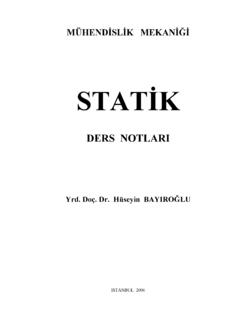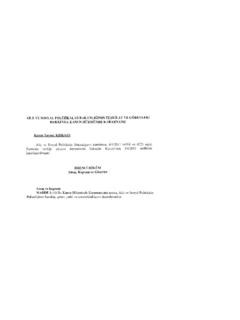Transcription of 2 What is econometrics? - Yıldız Teknik Üniversitesi
1 1 2. What is econometrics ? I Literal meaning: economic measurement: econo-metrics . INTRODUCTION I But the scope of econometrics is much wider. I Two popular definitions of econometrics : I econometrics may be defined as the social science in which useyin Ta stan1. H . the tools of economic theory, mathematics, and statistical 1 Y ld z Technical University inference are applied to the analysis of economic phenomena . Department of Economics ( Goldberger, 1964). These presentation notes are based on I .. econometrics may be defined as the quantitative analysis Introductory econometrics : A Modern Approach (2nd ed.) of actual economic phenomena based on the concurrent by J. Wooldridge. development of theory and observation, related by appropriate methods of science . (P.)
2 Samuelson). 14 Ekim 2012. 3 4. Scope of econometrics Components of econometrics I Developing statistical methods for the estimation of economic I Econometric inputs: relationships, I Economic Theory I Mathematics I Testing economic theories and hypothesis, I Statistical Theory I Evaluating and applying economic policies, I Data I Forecasting, I Computers (CPU power). I Interpretation I Collecting and analyzing nonexperimental or observational I Econometric outputs: data. I Estimation - Measurement I Inference - Hypothesis testing I Forecasting - Prediction I Evaluation 5 6. Why Do We Need econometrics ? Classical Methodology in econometrics I We learned statistical methods so why do we need a separate I Formulation of theory or hypothesis, discipline? I Specification of economic (mathematical) model, I The reason is as follows: econometrics focuses on the analysis I Specification of econometric model, of nonexperimental economic data.
3 I Collecting data, I Nonexperimental data (or observational data) are not I Estimation of parameters, obtained through controlled experiments on economic agents (consumers, firms, households, sectors, countries, etc.). I Hypothesis tests, I Experimental data are collected in laboratory environments I Forecasting/Prediction), in natural sciences. I Evaluation of results for policy analysis or decision making. I Although some social experiments can be devised it is usually (Gujarati, ). impossible to conduct economic experiments. I Unlike statistical methods employed in natural sciences, econometrics develops special methods to handle nonexperimental data. 7 8. ECONOMIC MODEL ECONOMIC MODEL vs. ECONOMETRIC MODEL. Example 1 - Economic Model of Crime Economic Model Example 2 - Job Training and Worker Productivity y = f (x1 , x2 , x3 , x4 , x5 , x6 , x7 ), wage = f (educ, exper, training), f functional form (not yet specified).
4 Description of variables wage: hourly wage (in dollars). educ: level of education (in years). I y: hours spent in criminal activities, exper : level of workforce experience (in years). I x1 : earnings for an hour spent in criminal activity, training : weeks spent in job training. I x2 : hourly wage in legal employment, Econometric Model: f Linear specification I x3 : other income, I x4 : probability of getting caught, wage = 0 + 1 educ + 2 exper + 3 training + u I x5 : probability of being convicted if caught, I x6 : expected sentence if convicted, I x7 : age 9 10. ECONOMETRIC MODEL: Linear Specification ECONOMETRIC MODEL: Linear Specification Econometric Model Example 2 - Job Training and Worker Econometric Model Example 2 - Job Training and Worker Productivity Productivity wage = 0 + 1 educ + 2 exper + 3 training + u wage = 0 + 1 educ + 2 exper + 3 training + u Components of econometric model: Components of econometric model: I u: random error term or disturbance term I 0 , 1 , 2 , 3 : parameters of the econometric model I Random error term u contains influence of factors that are I These are unknown constants.
5 Not included in the model. It also contains unobserved factors I They describe the directions and strengths of the relationship such as innate ability or family background. between wage and factors affecting wage included in the I No matter how comprehensive the specified model there will model. always factors that cannot be included in the econometric I For example, we may be interested in testing H0 : 3 = 0. model. We can never eliminate u entirely. which says that job training has no effect on wage. 11 12. ECONOMETRIC DATA TYPES ECONOMETRIC DATA TYPES. I Cross-sectional data Cross-sectional data: I Time series data I consists of a sample of individuals, households, firms, cities, I Pooled cross-section states, countries, or a variety of other units, taken at a given point in time I Panel data (longitudinal data).
6 I Significant feature: random sampling from a target population I Generally obtained through official records of individual units, surveys, questionnaires (data collection instrument that contains a series of questions designed for a specific purpose). I For example, household income, consumption and employment surveys conducted by the Turkish Statistical Institute (TUIK/TURKSTAT). 13 14. Cross-sectional data example: Wage Data (GRETL data ECONOMETRIC DATA TYPES. set: ) Time series data: A Cross-sectional data set on wages and individual I consists of observations on a variable or several variables over characteristics time. Obs. No wage educ exper female married I Chronological ordering 1 11 2 1 0 I Frequency of time series data: hour, day, week, month, year 2 12 22 1 1.
7 3 11 2 0 0 I Time length between observations is generally equal 4 8 44 0 1 I Examples of time series data include stock prices, money 5 12 7 0 1 supply, consumer price index, gross domestic product, annual 6 16 9 0 1 homicide rates, and automobile sales figures.. 524 15 13 0 1. 525 16 5 0 1. 526 14 5 1 0. 16. A Time Series Data Example: GRETL: ECONOMETRIC DATA TYPES. Pooled cross-section: I consists of cross-sectional data sets that are observed in different time periods and combined together I At each time period ( , year) a different random sample is chosen from population I Individual units are not the same I For example if we choose a random sample 400 firms in 2002. and choose another sample in 2010 and combine these cross-sectional data sets we obtain a pooled cross-section data set.
8 I Cross-sectional observations are pooled together over time. 18. A Pooled Cross-sectional Data Example ECONOMETRIC DATA TYPES. Panel Data (longitudinal data): I consists of a time series for each cross-sectional member in the data set. I The same cross-sectional units (firms, households, etc.) are followed over time. I For example: wage, education, and employment history for a set of individuals followed over a ten-year period. I Another example: cross-country data set for a 20 year period containing life expectancy, income inequality, real GDP per capita and other country characteristics. 20. A Panel Data Example Causality and the Notion of Ceteris Paribus I In testing economic theory usually our goal is to infer that one variable has a causal effect on another variable.
9 I Correlation may be suggestive but cannot be used to infer causality. I Fundamental notion: Ceteris paribus: other relevant factors being equal . I Or holding all other factors fixed . I Most economic questions are ceteris paribus by nature. I For example, in analyzing consumer demand, we are interested in knowing the effect of changing the price of a good on its quantity demanded, while holding all other factors (such as income, prices of other goods, and individual tastes) fixed. I If other factors are not held fixed, then we cannot know the causal effect of a price change on quantity demanded. 21 22. Causality and the Notion of Ceteris Paribus Ceteris Paribus Example: Effects of Fertilizer on Crop Yield I Therefore, the relevant question in econometric analysis is do I Suppose the crop is wheat.
10 We are interested in measuring the we control sufficient number of factors? impact of fertilizer on wheat yield (production). I Are there other factors that are not included in the model? I Obviously there are several factors that affect the production I Can we say that other components are held fixed? of wheat such as rainfall, quality of soil and presence of parasites. I In most serious applications the number of factors is immense so the isolation of the effect of any particular variable may I We need to control these factors in order to determine the seem hopeless. But, if properly used, econometric methods ceteris paribus impact of fertilizers. can help us determine ceteris paribus effects. I To do this we can devise the following experiment: divide the land into equal pieces (such as one acre) and apply different amounts of fertilizer to each land plot and then measure the wheat yield.







